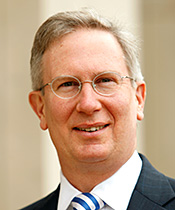A Ringing Endorsement of the Rule of Law
Paul G. Mahoney
 |
In this issue of the UVA Lawyer, we join lawyers throughout the English-speaking world in celebrating the upcoming 800th anniversary of Magna Carta. As Suzelle Smith ’83 puts it, Magna Carta is widely recognized as “the keystone of the rule of law.” One reason for its enduring power is that the concept of the rule of law is protean; it captures the notion that official power must be constrained by rules but it does not by itself indicate what those rules should be.
Magna Carta’s most revered provision, chapter 39, nicely illustrates the point. Its key phrase, forbidding punishment of freemen nisi per legale iudicium parium suorum vel per legem terre (except by the lawful judgment of his peers or by the law of the land), is often interpreted as recognizing a right to trial by jury and other procedural protections that we today call “due process.” But that interpretation is Sir Edward Coke’s from the 17th century; it was not what King John and his barons meant. Indeed, the use of the word “or” rather than “and” between “judgment of his peers” and “the law of the land” gives us our first hint that the modern reading is not quite right.
So, properly read, chapter 39 is a ringing endorsement of the rule of law, just not in the way we are used to reading it. It required the king to proceed against freemen only through formal trials in specified tribunals but did not indicate the procedures to be used in those tribunals. But even with those limitations, chapter 39 was a potent constraint on arbitrary royal power. In the past, kings had simply imprisoned and executed nobles they suspected of treason or disloyalty without any process at all. Requiring a formal legal proceeding even for the most sensitive and politically dangerous cases was a bold step. And Magna Carta accordingly deserves all the credit it receives today as an endorsement of due process, even if the processes it permitted were quite different from those we use now.
That flexibility ensures that Magna Carta is still cited today as authority in U.S. courts. Two of our most accomplished scholars, Professors Risa Goluboff and Fred Schauer, comment on this tendency in these pages. Risa points out the surprising, if small, role that Magna Carta played in the resurrection of substantive due process—now focused entirely on non-economic rights such as reproduction—by some of the same justices who roundly rejected the same concept as applied to economic rights. Fred reminds us that in the Anglo-American system, law is text as interpreted by the courts. Because the federal courts sometimes look to Magna Carta as an aid to interpreting the U.S. Constitution, the Great Charter can rightfully be said to form a part of the American constitutional order.
Our own Professor Dick Howard is one of the world’s foremost experts on Magna Carta. In the coming twelve months, he will speak on its meaning, importance, and legacy in multiple venues on both sides of the Atlantic. We can only hope its ideas remain relevant 800 years from now.




